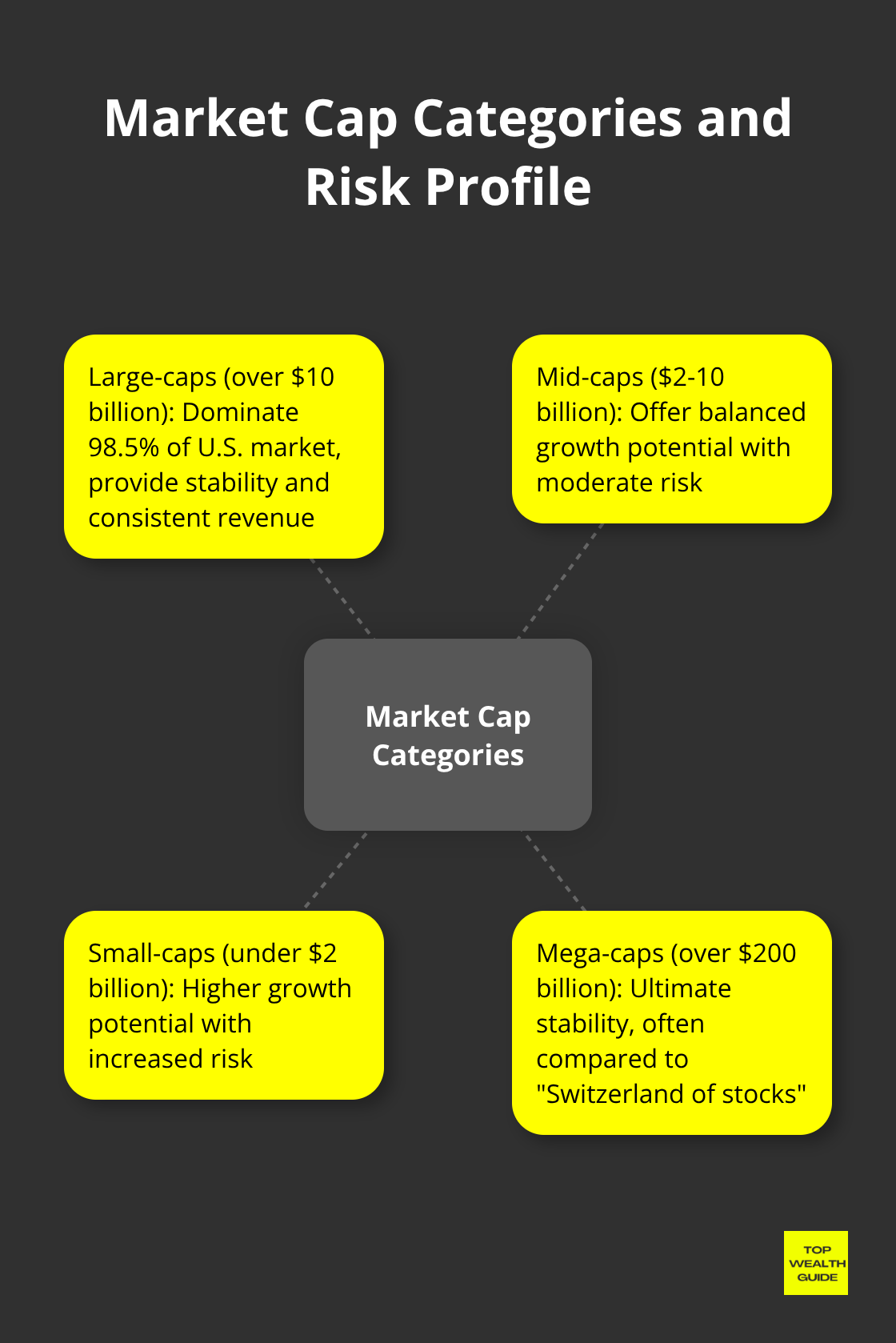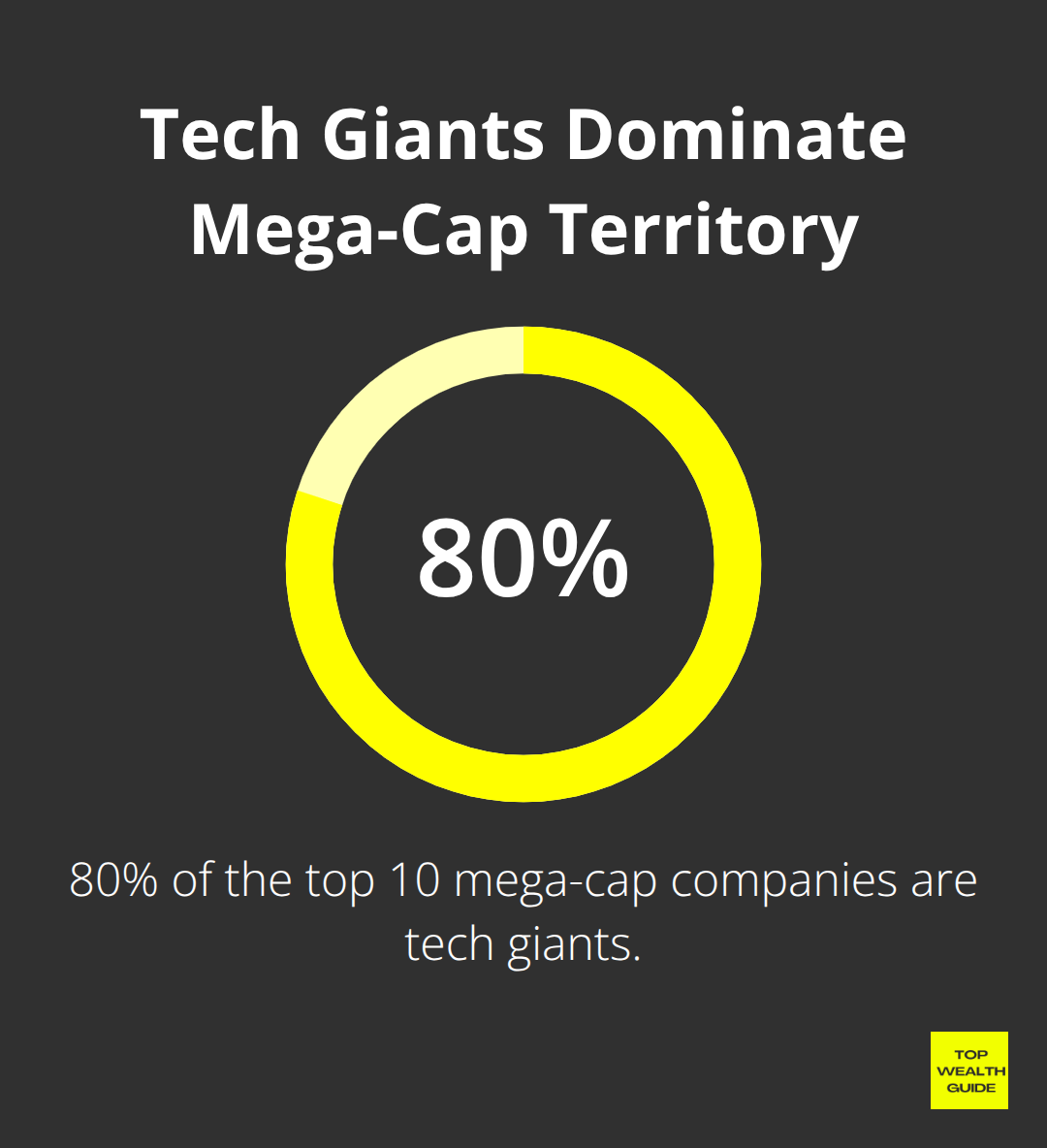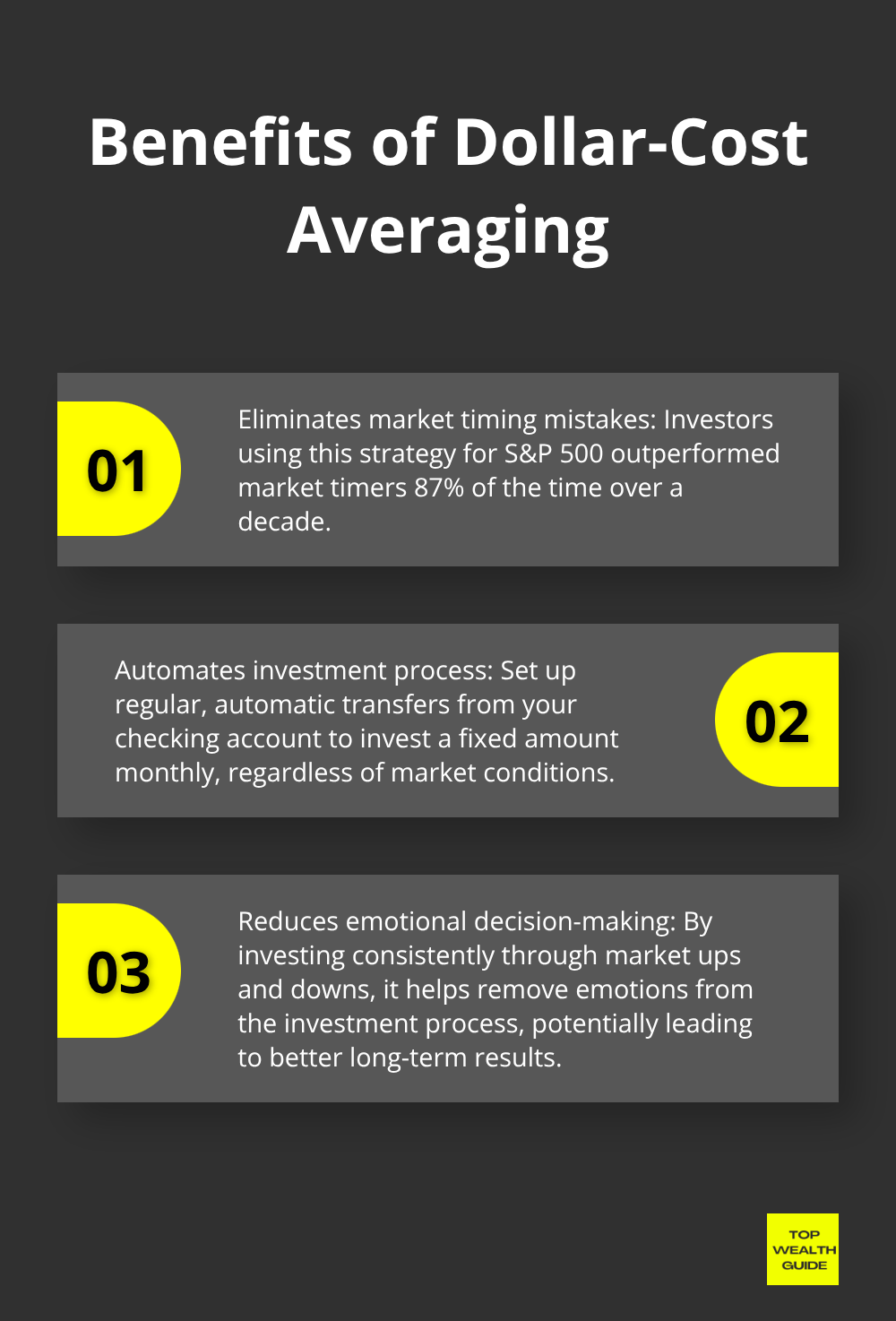The world’s largest companies — we’re talking trillions in market value here — have a stranglehold on global markets and investor portfolios. These big kahunas of the stock world are the titans of tech, healthcare, and consumer sectors.
At Top Wealth Guide, we’re crunching the numbers on the top 10 stocks by market cap… yep, that’s what we do. Why? Because getting a handle on these market leaders is like having the keys to the kingdom of stable, long-term wealth. We’re talking about riding on the coattails of proven corporate giants. So buckle up.
In This Guide
What Makes Market Cap Your Investment GPS?
Market cap-it’s like the North Star for your investments. How do we nail it down? Multiply those outstanding shares by the current stock price, and boom, you’ve got the total market value of a company. Take Apple, for example. Trading at $180 a pop with 15.7 billion shares floating around… do the math, and we’re talking a $2.8 trillion behemoth. This little equation? It’s your go-to for sizing up investment opportunities and gauging portfolio risk.
Market Cap Categories Define Your Risk Profile
Split up the stock world, and you’ve got categories that pretty much sum up your risk appetite. Large-caps (those over $10 billion) dominate 98.5% of the U.S. market-yeah, that’s a whole lot of juice (thanks, SEC data). Think Microsoft looming over everyone at $3.8 trillion and Nvidia strutting in at $4.3 trillion-these are your stabilizers, trusty giants with revenue streams that never sleep. Then you’ve got mid-caps ($2-10 billion) for when you feel like rolling the dice but still want some sleep at night… small-caps under $2 billion if you’re hungry for that potential rocket launch (with a good side of risk). Mega-caps over $200 billion? Your ultimate fortress… the Switzerland of stocks.

Portfolio Stability Through Large-Cap Dominance
Large-caps-they go the way the market goes, not against it. That’s why they make portfolios so darn predictable. When you’ve got the S&P 500 index weighing companies by market cap, guess who’s calling the shots? Apple, Microsoft, Amazon… the big dogs. This power is what’s creating stability. Deep cash reserves, diversified revenue lines, CEOs who don’t flinch in a storm-these firms weather market gales way better than the little guys.
Risk-Return Mathematics Favor Size
Looking at the historical track, the S&P 500 doles out about 10.54% annually since the late ’50s. But, factor in inflation, and you’re chilling at 6.68%. Sharp investors? They park 60-80% of equity in large-caps for that rock-solid backbone, 15-25% on mid-caps for a balanced growth ride, and sprinkle 5-15% on small-caps for an aggressive splash. This strategy? It’s golden for reducing portfolio volatility while catching growth waves across market segments.
So now that you’re dialed in on how market cap shapes the risk-return tango, let’s check out the companies making noise in the trillion-dollar playground.
Current Largest Stocks by Market Cap Analysis
So, here’s the deal – Nvidia just put a crown on its head with a $4 trillion market cap. And why? AI chips – they’re on fire, like the rollercoaster ride with no brakes. Then we’ve got Microsoft, sliding in at $3.77 trillion, raking in a cool $281.7 billion from all things cloud and software. Apple’s not letting go either, sitting pretty at $3.45 trillion with $408.6 billion streaming in from iPhones, Macs – all those toys we just can’t drop.
Alphabet’s flexing at $2.58 trillion, all while battling antitrust beasts over its ad empire. Meanwhile, Amazon’s got a $2.44 trillion valuation, thanks to its $670 billion revenue juggernaut and AWS’s cloud clout. These five titans? They’re strapped tight with over $17 trillion combined. Wild, right?
Tech Giants Control 80% of Mega-Cap Territory
Now, eight out of the top ten firms – all tech! It’s like a monopoly game gone haywire. Should you see opportunity or danger signs here? That’s the million-dollar question. And Meta Platforms – a 32.19% return this year ’cause advertising’s bouncing back and their metaverse bets are finally paying off.

Taiwan Semiconductor Manufacturing Company has the semiconductor scene locked down, even spreading its wings Stateside to keep up with chip craze. Tesla, trucking along with a $1.08 trillion tag, despite a few bumps on the road in 2025. And Broadcom? They’re beefing up their software artillery post-VMware grab, climbing to $1.4 trillion.
Traditional Sectors Fight for Relevance
Meanwhile, Saudi Aramco’s the lone ranger from the energy camp at $1.53 trillion – but oil prices, man… fluctuation city. Berkshire Hathaway – $1.09 trillion – thanks to Buffett’s mixed bag of investments across insurance, energy, and more. Then there’s JPMorgan Chase – financial services boss at $828 billion, even dipping toes in cryptocurrency with the classic banking schtick.
Geographic Concentration Creates Investment Vulnerabilities
U.S. companies – nine out of ten spots, holding the fort. Only Saudi Aramco’s the odd man out. This means if you’re into large-cap stocks, you’re basically holding American stock cards, whether you meant to or not. Tencent’s the big fish from China at $705 billion, but regulations – they’re a major roadblock for foreign investors.
So, how do you ride this giant wave? Do you dive in directly, or play it cool with broader indices – maybe those stocks with the highest dividend yields? Decisions, decisions…
Investment Strategies for Large-Cap Stocks
So, index funds… what’s the deal? They’re basically the one-stop shop for investors who want the best of all worlds-low costs, nifty diversification, tax chops, and returns you can actually predict (most of the time). You’ll find the Vanguard S&P 500 ETF charging a mere 0.03% annually while giving you keys to the kingdom of all 500 top dogs. Fidelity’s doing something bold, too-Zero Large Cap Index Fund charges zilch. That’s right-no fees. These funds have this neat way of automatically rebalancing as your companies either hit it big or fall apart… no need for you to babysit them around the clock. Now, if you’re picking individual stocks, it’s like betting on the Kentucky Derby but for companies-Apple, Microsoft, the usual suspects. But hey, one lousy earnings report, and poof! Your portfolio’s gone to the dogs. Index funds? They’re risk spreaders-hundreds of companies have your back.
Direct Investment Creates Unnecessary Concentration Risk
Single stock positions-essentially playing with fire. You’re exposed to disasters quicker than you can say “Enron 2001.” Anyone remember when Facebook took a nosedive-24% down in a single day back in 2018 during the whole Cambridge Analytica circus? Even those seemingly unstoppable titans like Netflix-yeah, they took a 75% dive from peak to trough in 2022. Ouch. But enter large-cap index funds as your diversification superheroes. The S&P 500 is a diversified fiesta that’s got 500 companies spanning 11 sectors. If one goes belly up… barely a wrinkle on your returns.
Dollar-Cost Averaging Eliminates Market Timing Mistakes
Ever heard of dollar-cost averaging? It’s like setting your investment cruise control. Plug $500 monthly into large-cap funds, come hell or high water. Vanguard’s got the stats-investors sticking with this S&P 500 strategy through ups and downs smoked market timers 87% of the time over a decade. Sure, Tesla dropped like a stone-65% in 2022-but by 2024, it skyrocketed to new highs. Timing geniuses who bought through the slump cleaned up. Set up those auto-transfers from your checking account each month… it’s like investment autopilot. Emotions out, wealth in-powered by market volatility.

Portfolio Allocation Must Match Your Risk Capacity
How should you slice the pie? If you’re over 40, go big-70-80% of your stocks should be in large-cap funds. Younger bucks? Try 60-70% in large-cap, with the rest thrown into the mid and small-cap mix for that extra spin of growth. Quarterlies are your friend-rebalance when you drift more than 5% from targets. JPMorgan’s done the homework-portfolios with 75% large-cap allocations are smooth sailing, much steadier than juggling all caps equally. And don’t miss the tax-advantaged playground-401k and Roth IRA-large-cap investments thrive in these, thanks to regular divvies.
Tax-Efficient Account Selection Maximizes Returns
Now, about those large-cap dividend stocks… they find their happy place in tax-shielded accounts. Apple’s tossing $0.24 per share quarterly, Microsoft’s sharing $0.75 per-nice little extras, right? In regular accounts, every cent is taxed as ordinary income but stashes in Roth IRAs? Tax-free wonderland. First, max out those 401k contributions ($23,000 limit in 2024), then slide into your Roth IRA ($7,000 limit). You’re left with taxable accounts for growth stocks that skip divvy payments… you call the shots when it’s time to realize those capital gains.
Final Thoughts
The top 10 stocks by market cap aren’t just investment opportunities – they’re the backbone of modern wealth creation. These trillion-dollar titans, like Nvidia banging out at $4.3 trillion and Microsoft cruising at $3.8 trillion, show serious resilience through market cycles and economic hiccups. Your journey starts with index funds … giving you instant access to these market juggernauts without needing to play the shell game of picking individual winners and losers.
Look at the Vanguard S&P 500 ETF – a recession-busting 0.03% fee gives you exposure to these market behemoths with a set-it-and-forget-it $500 monthly investment … or whatever fits into your piggy bank. According to Vanguard’s data, dollar-cost averaging outsmarts market timing 87% of the time – let that sink in. If you’re north of 40, funnel 70-80% of your equities into large-cap funds, or dial it back to 60-70% if you’re a spring chicken. And absolutely plug those tax-advantaged accounts first ($23,000 in your 401k, $7,000 in your Roth IRA for 2024).
Yes, there’s concentration risk – let’s face it, nine out of the top ten companies are American tech giants. But this dominance is a golden ticket for patient investors willing to sail with these seasoned captains. Over at Top Wealth Guide, we’re all about large-cap strategies, laying the groundwork for wealth through disciplined investing and compound growth … over the long haul, of course.
